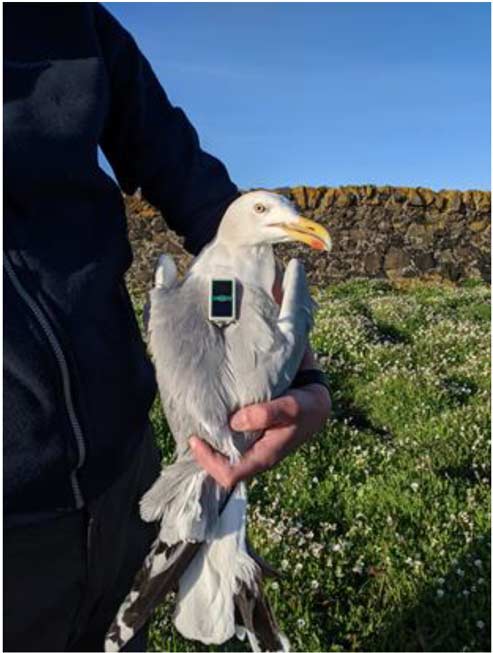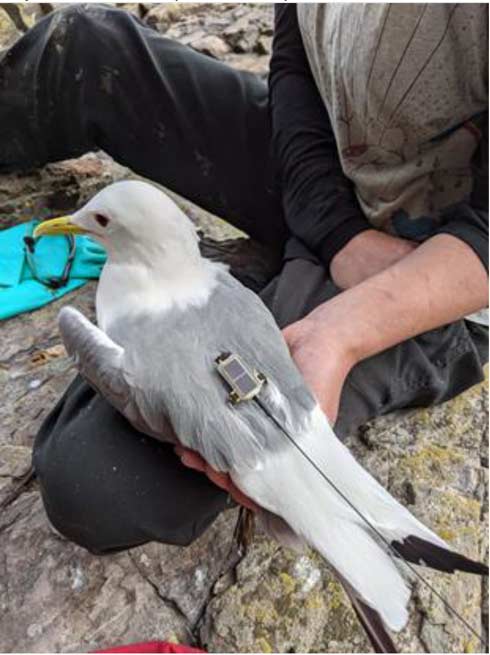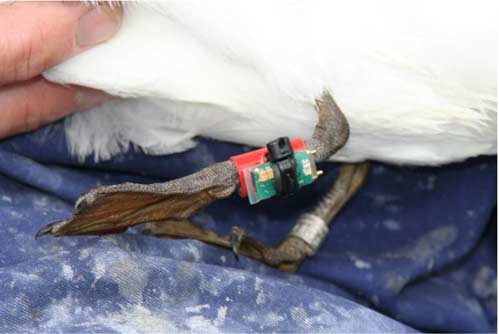Offshore wind energy - sectoral marine plan: seabird tagging feasibility
How to undertake a seabird tagging study for species and colonies potentially impacted by the sectoral marine plan for offshore wind energy
Tag attachment techniques
The ethical considerations for those undertaking biologging studies and the importance of not unduly impacting a bird’s welfare have been widely discussed (McMahon et al., 2011; Wilson & McMahon, 2006). Furthermore, any impact on a bird’s welfare may also cause biases in the data collected, undermining study aims. The attachment of devices to birds may have direct impacts on an individual’s health and/or its behaviour, potentially resulting in impacts on fitness, i.e. reproductive success and survival. Recent reviews have summarised potential impacts of bio-logging in a range of avian taxa (Barron et al., 2010; Bodey et al., 2018; Geen et al., 2019) and have highlighted the attachment method as an important factor that should be carefully considered. The attachment method should be suitable to both the device type used and the species.
Body harness
Body harnesses are regularly used for terrestrial species, especially raptors (Kenward, 1985), and more recently they have been used successfully on large gull species (Clewley et al., 2021) (Figure 7). They have the advantage that they allow year round or multiple year tracking of the same individual. The harnesses are usually constructed from a low abrasion Teflon ribbon material and recommended to be fit as a thoracic cross-strap design (Thaxter et al., 2014). Extensive trials were carried out on Herring and Lesser Black-backed Gulls across multiple sites and years and found no detectable differences in return rates or productivity for birds with and without harnesses (Clewley et al., 2021; Thaxter et al., 2016). The current recommendation in the UK is also to use a weak-link design where the harness is held together by a single component designed to break over time allowing the harness to detach from the bird without the need for recapture. The duration of deployment will depend on the weak-link material used and can vary from months to four years or more; details of harness design are reported in Clewley et al. (2021). A disadvantage of this method is in the increased handling time required to ensure a safe fit for long term attachment. Typical attachment times for experienced fieldworkers are 15-20 minutes. There are options to reduce fitting time, for example using a 4-point device housing designed to accommodate the weak-link harness design specifically, but it is considered that c.10 minutes will be the minimum for this method.
This design has also been trialled on other gull species including Kittiwake and Great Black-backed Gull in 2021. However, for both species it was deemed not suitable due to concerns about feather abrasion in Kittiwakes (Clewley et al., 2022) and increased rates of nest failure in Great Black-backed Gulls (Langlois et al. in review). It may be possible to modify the design or field methods for these species to enable safe use of harnesses, but that is still to be determined with further trials.
For diving species or those with rapid flight, such as auks, harnesses are not currently permitted in the UK over concerns of detrimental impacts caused by abrasion or drag.

Leg-loop harness
Leg-loops are an alternative design of harness that is positioned over the top of each leg placing the device in the centre of the lower back of the bird (Figure 8). This position avoids feather abrasion at the base of the wings for rapid flying species and has lower risk of impacts such as entanglement. A leg-loop design was trialled on Lesser Black-backed Gulls but judged to be inferior to body harness options due to reduced performance of the device (if solar powered due to shading) and reduced attachment duration (Thaxter et al. 2014). A trial of leg-loop harnesses on Kittiwake found them not to be suitable due to concerns with abrasion (Clewley et al. 2022). However, there are an increasing number of other waterbird species being successfully tracked in the UK using leg-loop harnesses which are constructed from different materials including silastic (Le Rest et al., 2019) and this may still be a viable method for some seabirds, pending further trials and evaluation.
There is also a cost to using leg-loops in terms of additional handling time, albeit less so than body harnesses, to ensure that the tension and fit is correct to reduce the likelihood of impacts directly from the harness. Typical fitting times for experienced fieldworks may be c. 10-15 minutes although this may be reduced to less than 10 minutes if little to no size adjustment is required and pre-sized harnesses are used.

Glue-mounting
Devices may be attached to the back of an individual using glue, most commonly superglue (cyanoacrylate). Recently this method has been used successfully on a range of waterbirds to attach GPS devices (Green et al., 2019) with typical deployment durations from 2-3 weeks up to several months depending on the specific attachment protocol and stage of moult of the bird (Figure 9). Attachment time for this method takes c. 10 minutes to ensure the device is fitted correctly, which will help maximise attachment duration as poorly fitted devices are likely to induce extra preening and removal of the device by the bird.
An area of feathers are trimmed on the back during attachment, which may interrupt waterproofing if not covered adequately by the device and section of fabric on the device base used to form the attachment surface. Glue-mounting has been carried out for Kittiwake (Wischnewski et al. 2017). However more detailed studies comparing at-sea behaviour of birds tagged with glue-mounted and tape-mounted devices, and at-colony behaviour of tagged and control birds, showed small negative effects of glue-mounted device deployment (Bogdanova et al., 2021a, 2022). Devices of different size and with different positioning on the body were used among the methods so further trials would be needed to tease apart the effects attributable to device size/type and to attachment location and method.
It is generally not considered suitable to use glue-mounting for diving species due to the risk of reducing plumage waterproofing, although it this has been trialled on Goosander (BTO, unpublished data).

Tape-mounting
The most suitable and commonly used method to attach devices to auks and Gannet is to tape-mount. Strong adhesive tape, often produced by Tesa (Hamburg, Germany), is used to secure the device to several feathers either on the back or central tail (Figure 10). This may be further reinforced with super glue or cable or similar ties or to help increase deployment duration. Tape-mounting is a short-term method with devices attached typically for several days up to a week before being shed following the failure of the tape. It does have the advantage of being suitable for diving species and very quick to attach with fitting times being typically c. 5 minutes or less.

Leg (ring) mount
Long-term deployment of devices is also possible by fitting to plastic leg rings (Figure 11). These may be secured to the ring with small cable ties and marine-grade epoxy resin glue and remain attached for several years or more. However, this is currently most suitable only for very light devices, such as geolocators, or those which don’t require a good solar recharging position. This method is very quick to deploy on birds, by just fitting an additional leg ring, and can be used on any of the species of interest in this study, but due to the limitations of suitable devices is restricted to collecting low spatial and temporal resolution location data. Leg mount methods are useful for deploying other biologging devices, such as time depth recorders. Additionally, devices fitted to leg rings are not typically capable of transmitting data and require that the individual is recaptured again to retrieve data. Hence there is an increased amount of fieldwork needed and some attrition of loggers as not all birds return or can be recaptured. Ability to recapture birds is likely to vary by species (e.g. Buckingham et al., 2021), consequently, the potential impact on individuals of carrying devices for longer than originally intended needs careful consideration. Assessments of device effects typically have low statistical power (Cleasby et al., 2021), and to our knowledge, no studies have addressed the fitness consequences of birds carrying leg-mounted devices for longer than intended. However, leg-mounted devices are typically very light, and are less likely to have device effects than other attachment methodologies (Bodey et al., 2018; Geen et al., 2019). Consequently, the fitness costs of carrying devices for longer than intended may be negligible, though this would benefit from further testing as additional data become available.
Figure 11 A geolocator deployed on leg ring (Photograph: UKCEH) 
Contact
Email: ScotMER@gov.scot
There is a problem
Thanks for your feedback